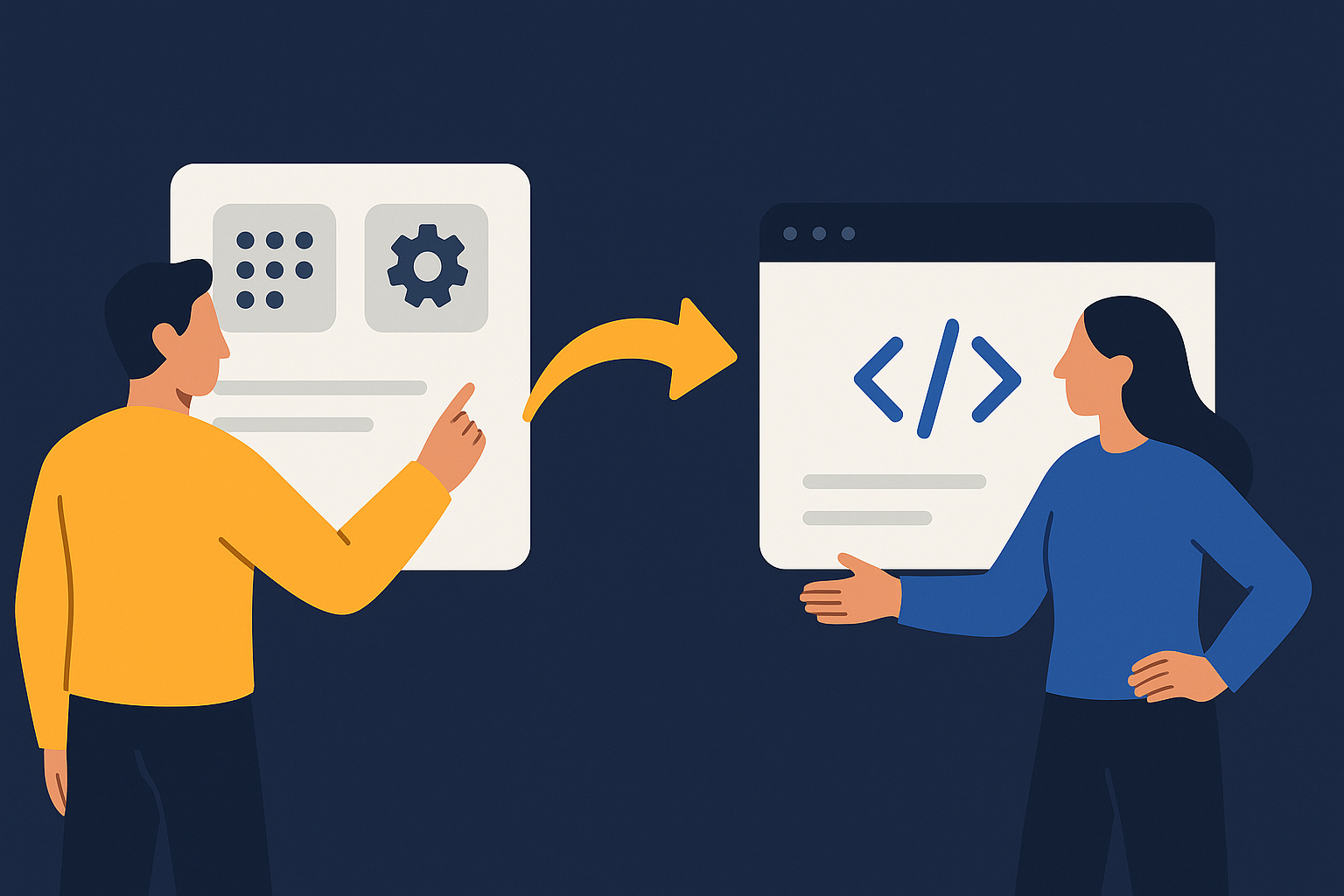Introduction

Low‑code and no‑code tools accelerate discovery and early validation. They’re fantastic for pilots, internal workflows, and proof‑of‑concepts. But the same characteristics that make them quick to start can make them hard to scale. As user volume grows, integrations multiply, and compliance obligations kick in, many teams hit a ceiling: rising run‑costs, vendor lock‑in, limited extensibility, and complicated release processes.
For C‑level leaders, product managers, founders, and marketing directors who now need reliability at scale, the question becomes less “Can we keep adding features?” and more “What’s the safest, most cost‑efficient path to a robust custom web application?” This guide lays out when to plan your exit from low‑code, how to de‑risk the migration, and which architecture patterns minimize downtime—drawing on our experience as a digital product design agency and custom web app development partner for enterprise application development and mobile app consulting.

The moment to exit low‑code arrives when growth, compliance, or extensibility demands exceed the platform’s envelope.
Event/Performer Details
- Who this is for: CIOs/CTOs, CPOs/VPs Product, startup founders post‑PMF, marketing directors owning mission‑critical web properties, and enterprise program managers.
- What you’ll learn: A practical, phased blueprint to migrate off low‑code platforms (e.g., website builders, form/workflow suites, or app factories) into a custom web or mobile stack without disrupting revenue or operations.
- Outcomes: A clear decision framework, architecture options, migration runbooks, and risk controls you can adopt immediately with your team or a partner.
Why You Shouldn’t Miss It
- Bulletproof your scale-up plan with concrete exit signals and thresholds.
- Cut run‑costs by moving to right‑sized infrastructure and license models.
- Reduce vendor lock‑in with open, testable architectures and portable data.
- Improve page speed, accessibility, and SEO by owning your rendering stack.
- Meet compliance and data‑residency needs with dedicated security controls.
- Align stakeholders using a migration scorecard and risk‑weighted roadmap.
The hidden costs of staying low‑code
Low‑code platforms solve real problems, but the trade‑offs compound at scale:
- Operational spend drifts upward. Per‑user or per‑environment licensing can outpace cloud hosting costs for equivalent usage. Add‑ons for analytics, role‑based access, or advanced workflow often stack fees.
- Delivery velocity plateaus. Extending beyond built‑ins usually means brittle workarounds, platform‑specific scripting, or vendor backlog dependency—slowing feature throughput.
- Integration friction. Complex event flows, multi‑region data, and domain-driven models are harder to express in generic builders than in code you control.
- Release risk. Platform updates ship on the vendor’s cadence, not yours. Breaking changes can ripple through critical journeys.
- Compliance limits. Granular data‑governance, audit trails, tenant isolation, or encryption-in-use often exceed the knobs available in out‑of‑the‑box builders.
If two or more of these describe your current state, it’s time to plan an exit.
Exit signals and thresholds
Use these criteria to time the move to a custom stack:
- Throughput: Your weekly design/development capacity is consistently constrained by platform limits, not team skill.
- TCO inflection: 12–18‑month run‑rate (licenses + proprietary add‑ons + indirect dev time) exceeds forecast custom stack costs by 20–30%.
- Extensibility gap: Must‑have features require unsupported patterns or risky workarounds.
- Data posture: You need sovereign storage, region‑aware routing, or precise retention policies that outstrip current options.
- SLOs: You can’t meet agreed performance/error budgets without bypassing the platform.
- Security: You need enterprise SSO, fine‑grained permissions, or private networking not natively supported.
A phased migration blueprint
The safest path is not a “big bang.” It’s an incremental strangler‑pattern program that carves off capabilities, data, and traffic in controlled slices.
Phase 0: Preparation and governance (2–4 weeks)
- Establish an executive sponsor, a cross‑functional core team (Product, Engineering, Security, Data, Marketing), and a steering cadence.
- Define north‑star KPIs: conversion, latency, availability, cost‑per‑transaction, and lead time for change.
- Compile a feature inventory with usage, business value, and technical dependencies.
- Create your “Migration Scorecard” (see Practical Information) to prioritize slices.
Phase 1: Build the foundation (3–6 weeks)
- Stand up a minimal platform: repo structure, CI/CD, observability, feature flags, and environment parity.
- Implement Identity and Access Management (OIDC/SAML), secrets management, and baseline compliance logging.
- Model core domain entities in a portable store (PostgreSQL/Document DB) with a well‑defined API layer.
Phase 2: Carve out low‑risk slices (4–8 weeks)
- Front‑end strangler: Introduce an edge router or CDN rules to direct specific routes to the new app, leaving the remainder on the legacy platform.
- Data sync: Use change‑data‑capture or scheduled ETL to mirror critical data sets bidirectionally while cutovers occur.
- Re‑platform “islands”: Self‑contained modules like pricing calculators, resource centers, or account settings are ideal first candidates.
Phase 3: Parallel‑run critical journeys (4–10 weeks)
- Shadow traffic: Mirror a percentage of read traffic to the new services for soak testing without user impact.
- Canary releases: Gradually increase user cohorts through feature flags. Monitor SLOs and roll back automatically on threshold breach.
- Sunset checkpoints: When a module maintains SLOs over a full business cycle, decommission its low‑code counterpart.
Phase 4: Decommission and optimize (2–6 weeks)
- Remove remaining dependencies, close integration tunnels, and revoke platform entitlements.
- Optimize infra for steady‑state: autoscaling policies, reserved capacity, caching, image optimization, and CDN edge logic.
- Institutionalize learning: Post‑mortems, runbooks, and playbooks feed the next modernization wave.
Architecture patterns that de‑risk the journey
- Strangler Fig facade: Place an API gateway or BFF (Backend‑for‑Frontend) in front of both systems. Route requests to new micro‑services as they come online.
- Event‑driven backbone: Use a message bus to decouple services. Start with read models and reporting to de‑risk; evolve toward transactional producers/consumers.
- Contract tests and consumer‑driven APIs: Lock service boundaries early; automate compatibility checks to avoid integration regressions.
- Domain‑aligned modular monolith: If micro‑services are overkill, use a modular monolith with explicit boundaries, separate modules, and independent release pipelines.
- Progressive enhancement front‑end: SSR or SSG for speed and SEO, hydrate with islands/components for interactivity.
Risk register and mitigations
- Data integrity: Use idempotent migrations, checksums, and dual‑write fallbacks during cutovers.
- SEO volatility: Maintain canonical URLs, 301s, and parity in meta/structured data. Validate with pre‑launch crawls.
- Analytics drift: Run both analytics stacks in parallel for one full reporting cycle to calibrate attribution.
- Stakeholder fatigue: Publish a visible migration burn‑down, weekly demo cadence, and a clear rollback policy.
- Hidden dependencies: Add contract tests around third‑party integrations (payments, search, CRM) before flipping traffic.
KPI framework to prove business value
- Performance: p75/p95 page load and API latencies; image and script weights; Core Web Vitals.
- Reliability: Availability, error budgets, and mean time to recovery.
- Velocity: Lead time for change, deployment frequency, and change failure rate.
- Growth: Conversion rates, session depth, and SEO metrics (indexed pages, impressions).
- Cost: Infra cost per 1,000 sessions or per transaction vs. prior licensing TCO.
Practical Information
- Migration Scorecard template:
- Business impact (H/M/L)
- Technical complexity (H/M/L)
- Dependency count
- Data criticality
- Rollback ease
- Owner and milestone
- Suggested team shape:
- Product Lead; Tech Lead; 2–4 full‑stack engineers; 1 UX/UI; 1 QA/SDET; 1 DevOps/Platform; Security liaison; Analytics specialist.
- Typical timeline bands:
- Small marketing site migration: 8–12 weeks.
- Mid‑size web application with auth and dashboards: 12–20 weeks.
- Enterprise application with complex workflows/integrations: multi‑quarter, staged by business capability.
- Budgeting pointers:
- Model against a 24‑month horizon including infra, maintenance, and team—not just build. Include a 10–15% contingency for discovery.
- Data migration checklist:
- Inventory PII/PHI; map lawful bases; define retention; plan region routing; implement encryption in transit/at rest; validate with synthetic data before production runs.
- Change management:
- Communicate in three layers: executive steering updates, team‑level demos, and front‑line runbooks. Celebrate each sunset milestone to maintain momentum.
Case‑style examples (anonymized)
- Marketing to product: A growth team outgrew a visual site builder. We rebuilt the front‑end with server‑side rendering for speed and SEO, kept the CMS for content entry during a bridge period, and gradually retired it as a headless backend took over. Results: 40% faster pages, simplified editorial workflow, and lower monthly spend.
- Workflow to platform: An internal operations tool on a workflow suite became revenue‑critical. We replicated core flows in a modular monolith, set up an event backbone for auditability, and parallel‑ran for six weeks before sunsetting. Results: audit‑ready logs, custom permissions, and predictable release cadence.
How CoreLine helps
As a custom web app development agency with deep UX/UI capabilities, product consulting, and enterprise application development experience, we specialize in:
- Exit strategy and business case modeling that ties migration to measurable ROI.
- Architecture and platform setup (CI/CD, observability, SSO, data posture) built for your risk profile.
- UX/UI re‑design that preserves conversion paths while improving usability and accessibility.
- Engineering execution across web, mobile, and integrations, with feature flags and progressive delivery.
- Mobile app consulting to determine when to keep or replace companion mobile experiences as the platform evolves.
Conclusion
Exiting low‑code isn’t about rejecting what got you here; it’s about graduating to a foundation that supports the next stage of growth. With the right timing, phased execution, and clear KPIs, you can reduce cost, improve velocity, and strengthen compliance—without interrupting customers or teams.
If you’re evaluating your own path from prototype to platform, we can help you plan and deliver a safe, cost‑efficient migration. Contact our team to scope your low‑code exit and de‑risk delivery.






